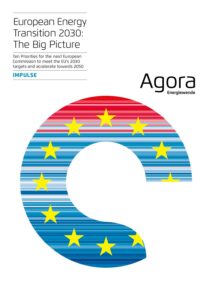In 2018, the EU has decided upon an climate and energy framework up to 2030. The aim is to have a clean, affordable and reliable energy system in Europe. To that end, greenhouse gas emissions are to decline by at least 40 percent below 1990 levels, renewables are to deliver 32 percent of our energy and efficiency is to improve by even 32.5 percent. But what do these targets really mean? How will Europe’s energy system look like in 2030? Which aspects of the transition are particularly important?
Against this background, we present you this report as a basis to understand where we are heading in Europe. For example, the overall renewables target translates into a Europe-wide 57 percent share of renewables in the power sector by 2030, implying that wind and solar will shape Europe’s power system. And the greenhouse gas target implies that coal will need to be cut by half, gas to be reduced by 30 percent and oil by 25 percent – asking for socially just concepts for this transition.
The European Energy Transition 2030 is a political project that concerns us all. It will demand European politics to address key issues to make it happen. In this report we suggest ten priorities and four flagship initiatives. The report is complemented by a technical document that translates the recommendations into a concrete work plan for the new Parliament and the new Commission.


